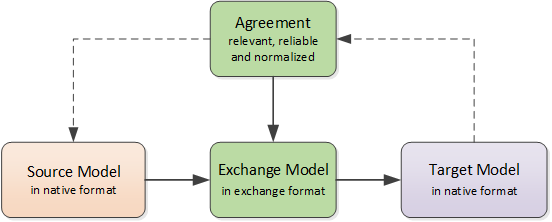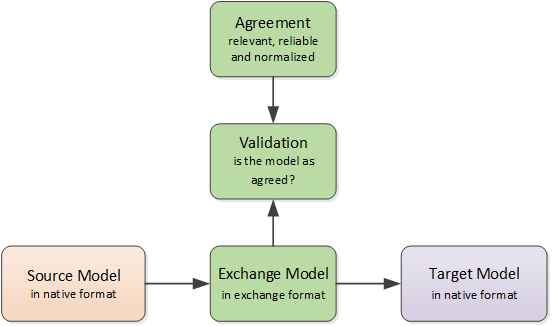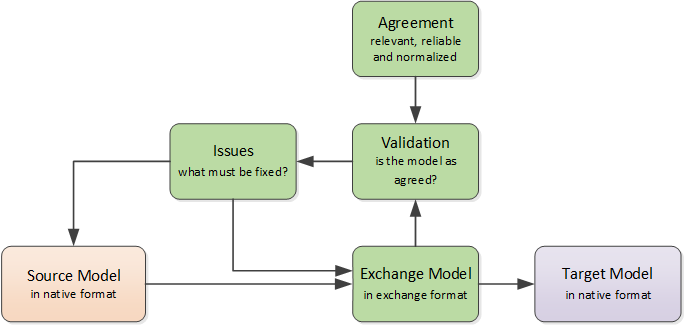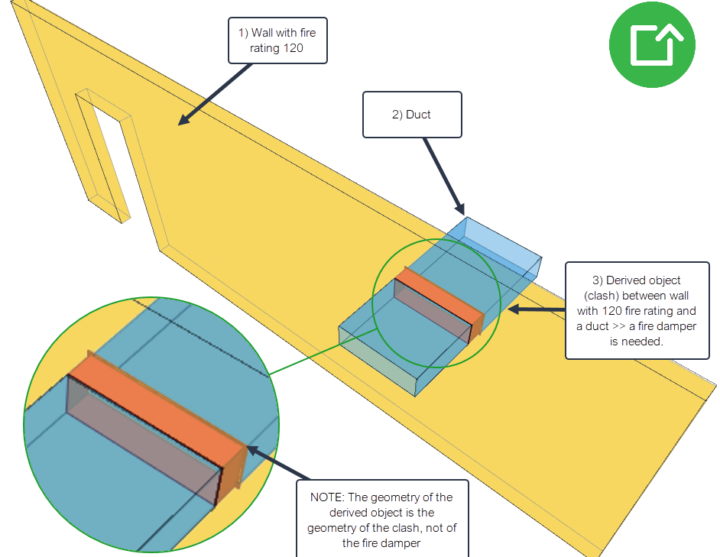Simple BIM Exchange Recipe
31.01.2017
Following this fairly simple recipe we can make sure that the BIM exchange produces the expected value for all involved parties. Everybody understand, in advance, the requirements and have the motivation to carry out the exchange professionally. Please note, that in this case BIM stands for building information model and in the exchange a BIM moves from one party to another.

The BIM is created, or authored by a designer using a BIM authoring application. In the case of an architect this could be for example ArchiCAD, Revit or Vectorworks, for structural designers Tekla or Revit, and for HVAC and electrical design some other design application. Each of these applications have their own internal native BIM format and while being developed by the model author, the model is stored in this format. I call this the Source Model.
For the exchange the BIM is exported from the BIM authoring application into some exchange format. This might be a file, like an IFC file, or the model may be published to a server. In any case the model is converted from the native format into the exchange format. I call the result of this conversion the Exchange Model. The Exchange Model typically only contains part of the data found in the Source Model.
The purpose of the exchange is to use the BIM in the receiving system, which could be a analysis application, for example quantity take-off, energy and indoor condition analysis or model checking. The receiving system could also be another BIM authoring application. The exchanged BIM is imported into the receiving system and converted into the native format of that system. The imported model becomes part of the internal model of the receiving system, which I call the Target Model. The Exchange Model is typically one of many inputs into the Target Model.
Usually the BIM moves in the exchange from one organization to another. In this case there has to be an agreement between the organizations that motivates both parties to carry out the exchange at the right time and with the required quality. But even if the exchange happens inside one organization the requirements for the content of the exchange itself must be clear and agreed in advance.

The agreement may affect how the Source Model is best created, but the agreement is always purely about the Exchange Model. This means that the agreement never says anything about the data content and structure of the Source Model. I will explain later why this is so important. The Target Model naturally affects the agreement, because the ultimate purpose of the Exchange Model is to provide a valuable input into the Target Model.
The BIM exchange agreement may take many forms, but it always defines the following kinds of requirements.
- The data must be relevant, i.e. it must be useful in the receiving system. Any data that is irrelevant will be in the best case simply ignored by the receiving system and in the worst case the whole exchange fails because of it.
- The data must be reliable because otherwise the results from the receiving system cannot be trusted. We want to avoid the garbage in, garbage out scenario.
- Because the exchange is between software applications, the data structures used in the exchange must be agreed. The Exchange Model must be normalized such that its data structures match what is required by the import functionality of the receiving system.

A well formulated agreement allows us to validate the Exchange Model during the exchange to determine if the model that is being exchanged is as agreed. This way we can find out if the Exchange Model is valid input into the receiving system. At this point we are not checking the design, only validating the quality of the model. It is the task of the receiving system to tell us about the quality of the design in the form of scope, cost, energy efficiency, clash detection and other analysis. But all these analysis depend on good quality input to produce reliable results.

Often the Exchange Model does not meet all our requirements and the validation produces issues that tell us what must be fixed. These fixes can be done to the Source Model, the Exchange Model or both. When all issues are fixed and the validation passes, the Exchange Model can be imported into the receiving system where it works like a dream.
One key concept is to set the requirements purely for the Exchange Model. This allows an independent 3rd party validation of the exchange by dedicated software developed for this purpose or a specialized consultant. In this scenario the responsibility of the model author is to deliver an Exchange Model that meets the commonly agreed requirements. When this is done and the validation passes, the use of the Exchange Model becomes the responsibility of the user of the receiving system.
As you can see the principles are fairly simple. The Exchange Model is only a part of the Source Model and it becomes part of the Target Model. In the middle the Exchange Model can be transformed and edited to fit the requirements of the receiving system and validation tells us when this work is done. When we make a clear agreement in advance, everybody knows what is expected from them and what they can expect from others. This allows us to set a realistic schedule and choose the right resources. It also enables professional, fair and predictable business models that benefit and motivate all parties.
How this relates to the Simplebim® application
The role of Simplebim® is to improve the quality of IFC based data exchange by fully supporting the process described above. You import the Exchange Model (IFC) into Simplebim®. The first step in Simplebim® is to trim the model such that it contains only the required objects and properties. The Agreement can be captured as Simplebim® templates that contain validation rules for the model. When the validation finds issues these can be corrected in Simplebim® using its many copy-editing features. When you copy-edit the model the validation is updated real-time. The issues can also be communicated to the author of the Source Model using the BCF format. Finally, a new IFC Exchange Model is exported from Simplebim® for use in the receiving system. This new model contains only relevant data, all relevant data is reliable and is structured such that the receiving system can import it without problems.


